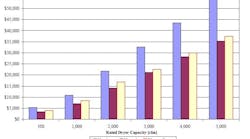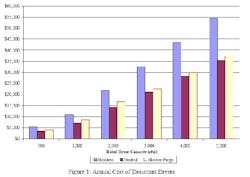The economics of operating regenerative desiccant dryers
Regenerative desiccant dryers are used in compressed air systems that require dew points to be below the minimum that refrigerated dryers can produce (generally 40 degrees Fahrenheit). Three types of regenerative desiccant dryers are widely used throughout industry: heatless, heated and blower purge.
The following discussion doesn’t address heat-of-compression (HOC) desiccant dryers, even though they require the least amount of energy to operate. The use of HOC dryers is limited to lubricant-free compressors.
Many plants require air quality that only regenerative desiccant dryers can produce. Unfortunately, in too many cases, the decision about which type of regenerative dryer to purchase is based on initial capital cost alone. This decision basis ignores the cost of energy that will be required to operate the dryer. Including energy cost can alter the economics of a purchase decision dramatically.
|
View more content on PlantServices.com |
Regenerative desiccant dryers use a desiccant medium to remove moisture from the compressed air stream. Wet air passes directly through the desiccant medium, which then adsorbs the moisture. The desiccant medium has a finite capacity for adsorbing moisture before it must be dried out, or regenerated. To do this, the tower containing saturated desiccant medium is depressurized and the accumulated water is driven off using purge air, heat or a combination of both. Desiccant dryers are generally of a twin-tower construction, with each tower containing its own desiccant bed. This allows one bed to dry compressed air as the other undergoes regeneration.
The energy cost associated with operating a desiccant dryer depends primarily on how the desiccant is regenerated — using purge air, heat or a combination of both. Desiccant dryers are categorized by their method of regeneration, the three primary types of which are:
- Heatless, which uses only compressed air as a purge
- Heated, which uses both heat and compressed air to purge moisture
- Blower purge, which uses air from an external blower, heat and minimal compressed air
The energy cost to operate each of these dryers depends on the amount of purge air used, the heater size and the blower motor size.
Heatless desiccant dryer
Heatless desiccant dryers use treated, unheated compressed air to regenerate the desiccant bed. This dryer is the most expensive to operate because of the large amount of compressed air that’s consumed for purging during the regeneration cycle. Typically, 15% of the rated flow capacity of the desiccant dryer is consumed as purge air. This is a significant amount of expensive compressed air to be used in this manner. In many facilities that operate heatless units, the air dryers are the largest single user of compressed air at the facility. Although the cost to operate this type of dryer is high, the heatless type is often selected because it has the lowest initial cost of any desiccant dryer.
Heated desiccant dryer
Generally, heated desiccant dryers have the lowest energy operating cost of the three types. A heating element supplements the drying action of the purge air. The heater can be mounted internally to heat the desiccant bed directly or externally to heat the purge air that’s blown through the bed.
Internal heating elements shorten the life cycle of desiccant beds and may cause dew point spikes. Therefore, they are not recommended and are not covered here. Like heatless dryers, the purge is compressed air supplied from the system. However, the amount of air required is reduced because the heat supplements the air’s drying action.
The amount of purge air an externally heated dryer requires varies by manufacturer, but is typically about 7% of the dryer’s rated flow capacity. The combination of heat and purge air is more energy efficient than purge air alone, yielding lower energy costs.
Blower purge desiccant dryer
Like heated-type desiccant dryers, blower purge-type dryers supplement the drying action of purge air with heat. In a blower purge desiccant dryer, however, the purge air is ambient air supplied by an electric blower. The typical blower supplies the entire purge air load, which is typically 20% of the dryer’s rated flow. Depending on the dryer design, blower purge-type dryers may still consume a small amount of compressed air that cools the bed at the end of the regeneration cycle. Blower purge-type dryers are generally more expensive to operate than the heated type, but less expensive to operate than the heatless variety.
Determining your own energy costs
So, we know that heatless desiccant dyers are the most expensive to operate in terms of energy costs, heated dryers are the least expensive, and blower purge dryers are somewhere in between. But, how can plant management quantify these costs so they can be used to make an informed decision when purchasing a desiccant dryer? Table 1 shows the appropriate equations you can use to calculate the energy cost to operate each type of desiccant dryer.
Table 1. Use these formulae to calculate your own operating costs. Click to enlarge
These equations can be used with dryer manufacturer specifications to determine the energy cost to operate the unit. The equations, with generalized manufacturer dryer specifications, were used to develop Figure 1, which summarizes the energy cost associated with the operation of heatless, heated and blower purge desiccant dryers.
Figure 1: Annual operating cost of desiccant dryers. Data assumes 8,760 operating hours per year, $0.05/kWh utility rate, compressor generation efficiency of 4.5 cfm/hp and compressed air and ambient air temperature of 100°F.
The heatless desiccant dryer is the most expensive type to operate at any capacity, while the heated type is the least expensive to operate at any capacity. The magnitude of difference between the heated and blower purge type is fairly small, indicating that users should base any decisions between these two types on other factors (initial cost, maintenance costs, excess capacity for purge air, etc.)
What about controls?
Manufacturers of desiccant dryers provide optional controls that can reduce the dryer’s operational cost. The most widely used control is the dew point demand controller. It uses a probe that continuously monitors the compressed air leaving the drying tower. It’s configured to delay regeneration until the exit air reaches the user’s maximum allowable dew point. The controller bases regeneration on dryer performance instead of a timed cycle, thereby reducing the number of regeneration cycles. Controls such as these can yield 30% to 80% in energy savings, depending on the maximum allowable dew point. Savings achievable using these controls must be calculated on a case-by-case basis.
Controls reduce cycling frequency, resulting in lower overall maintenance and longer desiccant and valve life. Although the cost of controls increase the dryer’s purchase price, the benefits they provide can pay back the initial cost quickly.
Desiccant air dryers are a proven and effective technology that can provide extremely dry air. However, they can be expensive to operate in terms of energy costs, and every plant professional who needs a desiccant dryer should be aware of these costs before going out for bids. Using the equations laid out here, you can determine what your energy costs will be and make informed decisions about what type of desiccant dryer is best for your application.
Andrew Sheaffer and Noel Corral are research engineers at the Energy Resources Center at the University of Illinois at Chicago. Contact Corral at [email protected] and (312) 413-8546. Contact Sheaffer at [email protected] and (312) 413-3615.


